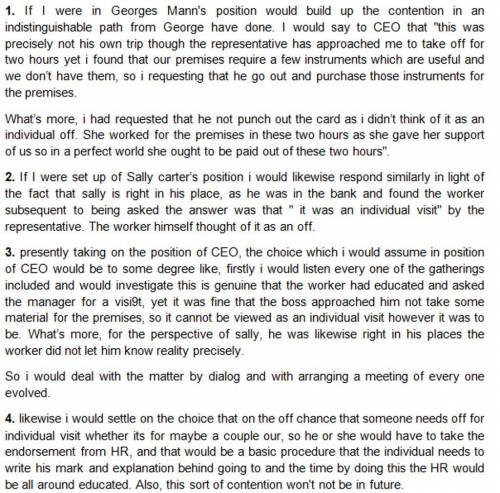
CASE: CHARTING A COURSE FOR CONFLICT RESOLUTION—"IT’S A POLICY" Background The setting is an 82-bed hospital located in a small city. One day an employee of the maintenance department asked the supervisor, George Mann, for an hour or two off to take care of some per-sonal business. Mann agreed, and he asked the employee to stop at the garden equipment dealer-ship and buy several small lawnmower parts that the department required. While transacting business at a local bank, the employee was seen by Sally Carter, the supervisor of both human resources and payroll, who was in the bank on hospital business. Carter asked the employee what he was doing there and was told the visit was personal. On returning to the hospital, Sally Carter examined the employee’s time card. The employee had not punched out to indicate when he had left the hospital. Carter noted the time the employee returned, and after the normal working day she marked the card to indicate an absence of 2 hours on personal business. Carter advised the chief executive officer (CEO), Jane Arnold, of what she had done, citing a long-standing policy (in their dusty, and some would say infrequently used, policy manual) requiring an employee to punch out when leaving the premises on personal busi-ness. The CEO agreed with Sally Carter’s action. Carter advised Mann of the action and stated that the employee would not be paid for the 2 hours he was gone. Mann was angry. He said he had told the employee not to punch out because he had asked him to pick up some parts on his trip; however, he conceded that the employee’s personal business was probably the greater part of the trip. Carter replied that Mann had no business doing what he had done and that it was his—Mann’s—poor management that had caused the employee to suffer. Mann appealed to the CEO to reopen the matter based on his claim that there was an important side to the story that she had not yet heard. Jane Arnold agreed to hear both managers state their position.
Instructions
1. In either paragraph form or as a list of points, develop the argument you would be advanc-ing if you were in George Mann’s position.
2. In similar fashion, thoroughly develop the argument you would advance if you were in Sally Carter’s position.
3. Assuming the position of the CEO, Jane Arnold, render a decision. Document your deci-sion in whatever detail may be necessary, complete with explanation of why you decided in this fashion.
4. Based on your responses to Questions 1 to 3, outline whatever steps—policy changes, guidelines, payroll requirements, or something else—you believe should be considered to minimize the chances of similar conflict in the future.

Answers: 1


Another question on Business

Business, 22.06.2019 11:30
Consider derek's budget information: materials to be used totals $64,750; direct labor totals $198,400; factory overhead totals $394,800; work in process inventory january 1, $189,100; and work in progress inventory on december 31, $197,600. what is the budgeted cost of goods manufactured for the year? a. $1,044,650 b. $649,450 c. $657,950 d. $197,600
Answers: 3

Business, 22.06.2019 12:20
If jobs have been undercosted due to underallocation of manufacturing overhead, then cost of goods sold (cogs) is too low and which of the following corrections must be made? a. decrease cogs for double the amount of the underallocation b. increase cogs for double the amount of the underallocation c. decrease cogs for the amount of the underallocation d. increase cogs for the amount of the underallocation
Answers: 3

Business, 22.06.2019 17:30
Four students are at an extracurricular activity fair at their high school and are trying to decide which clubs to join. some information about the students is listed in this chart: which describes which ctso each student should join?
Answers: 1

Business, 22.06.2019 17:50
Abc factory produces 24,000 units. the cost sheet gives the following information: direct materials rs. 1,20,000direct labour rs. 84,000variable overheads rs. 48,000semi variable overheads rs. 28,000fixed overheads rs. 80,000total cost rs. 3,60,000presently the product is sold at rs. 20 per unit.the management proposes to increase the production by 3,000 units for sales in the foreign market . it is estimated that semi variable overheads will increase by rs. 1,000. but the product will be sold at rs. 14 per unit in the foreign market. however, no additional capital expenditure will be incurredq-1. what is present profit of the company ? q-2. what is proposed profit of the company in new market? q-3.what is suggestion for new makret proposal whether proposal accept or not
Answers: 1
You know the right answer?
CASE: CHARTING A COURSE FOR CONFLICT RESOLUTION—"IT’S A POLICY" Background The setting is an 82-bed...
Questions




Spanish, 08.03.2021 06:20

Physics, 08.03.2021 06:20

Biology, 08.03.2021 06:20

Mathematics, 08.03.2021 06:20

History, 08.03.2021 06:20

Mathematics, 08.03.2021 06:20

Mathematics, 08.03.2021 06:20

Business, 08.03.2021 06:20




Mathematics, 08.03.2021 06:20


Mathematics, 08.03.2021 06:20

English, 08.03.2021 06:20

Mathematics, 08.03.2021 06:20





